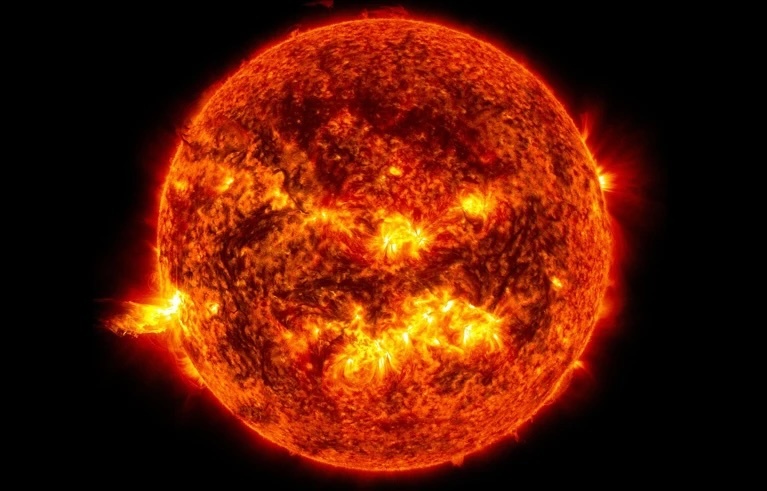15.12.2024
Ultra-sensitive detectors have observed neutrinos from the Sun, whose signals mimic those expected to be produced by elusive dark matter.

Most neutrinos that stream through Earth are produced by fusion reactions in the Sun.Credit: NASA/Goddard/SDO
Physicists in Italy and China have for the first time observed glimmers of the ‘neutrino fog’, signals from neutrinos that mimic those expected to be produced by dark matter.
The observations are a double-edged sword, says Nicole Bell, a theoretical physicist at the University of Melbourne, Australia. On the one hand, it means that detectors have become sensitive enough to pick up signals of dark matter — the mysterious substance thought to make up the bulk of matter in the Universe. On the other, it means that the neutrino signals could obscure the dark-matter signals that scientists are so eager to observe. The findings were published in two papers in Physical Review Letters last month1,2.
Every second, trillions of neutrinos stream through Earth — unnoticed, because they barely interact with ordinary matter. Most of these almost massless particles are produced by fusion reactions in the Sun, such as those that trigger the radioactive β-decay of the isotope boron-8.
Physicists have long predicted that dark-matter experiments will eventually catch a glimpse of this neutrino fog, formerly known as the neutrino floor, says Fei Gao, an experimental particle physicist at Tsinghua University in Beijing. He works on the XENONnt dark-matter experiment at the Gran Sasso National Laboratory just outside L’Aquila, Italy.
The neutrino fog is also exciting because measuring it confirms that dark-matter experiments are capable of observing all ‘flavours’ of neutrinos flying in from the Sun and even from exploding stars in nearby galaxies, says Kate Scholberg, an experimental particle physicist at Duke University in Durham, North Carolina. “You could learn something about the total spectrum of all neutrinos,” she says.
Dedicated search
The teams at XENONnT and PandaX-4T — another dark-matter experiment, at the China Jinping Underground Laboratory in Sichuan province — spent two years searching for boron-8 solar neutrinos using liquid xenon detectors. They focused on detecting neutrinos that slammed into xenon atoms’ whole nuclei rather than their individual parts, a process known as coherent elastic neutrino–nucleus scattering. These events produce signals that are remarkably similar to those that will be produced if certain types of weakly interacting massive particle (WIMP) — the leading candidate group for dark matter — hit a xenon nucleus.
The XENONnT researchers analysed their data set using an array of machine-learning techniques and concluded that the detector had captured 11 instances of solar neutrinos crashing into xenon nuclei1. Meanwhile, the PandaX-4T team detected 75 of these events2 by reducing the experiment’s detection threshold to 0.33 kiloelectronvolts — an order of magnitude lower than most WIMP searches, says team member Qing Lin, an experimental particle physicist at the University of Science and Technology of China in Hefei. This made the experiment more sensitive to the faintest neutrino signals, but meant that the data set was noisier than XENONnT’s because it included more signals from radiation and electrons.
Neither team’s results had a statistical significance higher than 3σ — the benchmark for reliable evidence in physics — but they match predictions of how solar neutrinos would interact with dark-matter detectors, says Bell. This suggests that the observations are the first hint of the neutrino fog. “They’ve shown up exactly where we expected them to be,” she says.
It will be a while before signals from the neutrino fog interfere with experiments searching for dark matter, says Scholberg, because solar neutrinos would mask only some types of WIMP. “We’re just starting to reach the limits, but we’re still far away from the end,” she says.
A bigger concern for future dark-matter searches will be neutrinos produced in Earth’s atmosphere rather than in the Sun, says Juan Collar, an experimental physicist at the University of Chicago, Illinois. These atmospheric neutrinos will make things even foggier, because they will obscure signals from dark-matter particles of all masses. But there is still much to be learnt from the neutrino fog itself before it becomes a real problem, says Collar. “It’s kind of bittersweet,” he says.
Quelle: nature
